

Plexus
Will Cooke, Annelies Jahn, Ham Darroch, Lieutenant + Vassallo, Nadia Odlum, Katy Mutton, Britt Salt
18 Sep–5 Oct 2019
Plexus was a group show of Australian artists who work with geometric abstraction and spatial intervention. These ‘process-based’ abstractionists each used self-designed systems to generate their artworks. Deriving from the Latin ‘to braid’, the title refers to an intricate system or network of parts. This term could refer to the intricacies in each individual’s art making. In bringing this group of artists together, their creative systems interwove creating a larger ‘plexus’.
The artists in Plexus could be described as ‘process-based’ abstractionists. Using repetitious and laborious actions to create artworks, they shared an interest in geometry and spatial intervention.
These artists had an intense devotion to their self-designed ‘systems of making’. Each had been slowly developed over years and years of studio-based research, constantly making and refining the smallest of details. These systems were a sophisticated, highly intricate and maybe even unnecessarily elaborate way to generate their final artworks. It is a process that is unseen to the public, but one that is a necessity for these artworks to exist. In bringing artists together that share such a detailed approach to art making, viewers were reminded of the often-unbelievable lengths artists go to in making their artworks.
While the systems used to make these artworks highlight artistic labour, the end product was far from a show of personal expression. The intimacy of the time spent sweating it out in the studio is, for the most part, hidden by the polished finish of these artworks. They are Post Minimalist and mechanical, cool and detached, shiny and clean. This tension between the creation and finish of the work became a focus of the exhibition. In a way, it echoed a similar tension evident in contemporary life. It was like the coldness of scrolling through social media on your smart-phone, connecting with your loved ones through the endless cold interfaces.
The artworks in Plexus ranged from large-scale, site-responsive installation, to more traditional sculptural and wall hanging pieces. Bringing these artworks together, each the product of its own unique and laborious system, implied a larger network of creative production to be decoded by visitors. Initially the immersive space had been designed to slow down viewers, inviting them to take a closer look at these artworks and decipher the systems behind them. They had to get up close to look for the subtle presence of the artists hand in these artworks.
Plexus brought together a group of Australian artists working with geometric abstraction and spatial intervention. Focused on process and materiality, these abstractionists used self-designed systems to help generate their artworks. Deriving from the Latin ‘to braid’, plexus refers to an intricate system or network of parts. In this context, systems and networks were reflected both in the art making of each individual and the way these artworks wove together within the gallery space.
Geometric abstraction has a history of communicating our experience in the built environment. Three small-scale works on paper by Nadia Odlum considered individuals navigating space. Her process begans by observing people in public environments, mapping out their trajectories and considering the way their actions were shaped by the surrounding architecture. These observations often led to spatial interventions, using vinyl, wood, steel, mirrors and/or painted surfaces to create immersive installations, she reflected the built environment back to the public. These studies led to a large-scale, site-responsive vinyl artwork, applied to the floor in the space where Odlum originally observed the patterns of movement. A loop of process is formed, from observing large-scale movement, to small-scale mapping and digesting in the studio, then returning back to immersive scale. The studies reflected the quietest moment in this loop, an artist working through their ideas. Using gouache on paper to map out pathways that overlap and zigzag, this meditative and precise act of making reflected an internal thought made public.
In a similar way, Will Cooke’s work felt like the product of visualising the meditative thought processes that happen in the studio. Working on the boundary of handmade and mechanical art making, his process incorporated repetitious layering of airbrushed stencils. The outcome was precise, but the process left space for the materials to dictate the direction an artwork would take. Unexpected outcomes or slippages that occur throughout the layering process were reminiscent of misregistration in industrial print processes. But these small moments were what make Cooke’s work feel intimate and personal.
Katy Mutton was also working through incorporating mechanical and digital processes into her art practice. She was focused on research into data visualisation, visual language systems and propaganda. Thinking through ideas on data mining and population surveillance, the work employed 3D printing to connect thousands of small ‘scales’ to tulle fabric. The contrast of the hard and soft created a unique materiality. Her work was at once celebrating the digital, while being suspicious of it. Mutton was taking digital ideas and planting them firmly in our real, tactile world.
Like many of the artists in this show, Britt Salt was focused on spatial engagement and response. Navigating materially driven processes of repetition and pattern making, her work responded to both art and architecture. Often working to enormous scale, it felt as natural to see her artwork occupying vast space among architectural structures as it did within the confines of a gallery. Her artwork often featured multiple picture planes and optical play that appeared to be expanding or contracting. Like the Light and Space artists from West-Coast America in the 60s, Salt worked with a kind of minimalism that was always in flux. Reliant on the viewer within the space to activate the installation, it was translucent, mobile and shifting. The intricacy and layering of the subtle pattern evoked a sense of camouflage, at once illusionistic and simple. There was no single vantage point to view this piece. Viewers in the space became active, no longer passive bystanders but initiators who were actively navigating and experiencing.
Lieutenant + Vassallo also specialise in interventions in the built environment. The visual artist pair collaborated using geometric wall painting as a tool to visually investigate and interrogate architectural spaces. Often using patterning like camouflage, they at once responded to the spaces they worked within while obliterating their surfaces with colour and form. Working in the grey area between art and design, the pair used collaboration and instruction as a way to question authorship and remove personal expression from their work.
Also working with instructionally created spatial installation, Annelies Jahn presented an artwork that began with an element of chance. In 2016 Jahn made the artwork 5 x 9, installing and removing a grid of found cardboard boxes pinned directly to the wall. After removing the artwork, she was struck by the grid of pinholes left behind, disturbing with the otherwise pristine gallery wall. Maximising on this serendipitous moment, the artist began putting pins back into the holes of the grid. Connecting the pins with string made a new artwork, the 5 x 9 series was born. We saw the latest iteration installed in Plexus. Jahn developed a set of instructions to replicate the original process, while also responding to the dimensions of Blindside’s gallery space. These new instructions incorporated a level of chance and serendipity that made the piece feel both logical and organic.
While Jahn uses her past artworks as building blocks for new pieces, Ham Darroch had similar serendipitous moments when painting onto found objects. Sourcing and working onto objects that have had a previous life, he used the formal elements of these utilitarian objects as a starting point. He then applied colour and pattern to the object’s surfaces with meticulous and precise detail. Patterns skimming across the worn surfaces feel spontaneous, like little bursts of new life. Despite the painted colours looking geometric and sharp, the angles and forms that emerged were playful and fluctuating. Some alluded to optical perspective; others appeared to be tumbling off the surface. This object augmentation went beyond simple decoration or embellishment. These objects had been deeply considered and cared for. In choosing to paint on the flat plane of the floats, Darroch was somewhat subverting these objects. We saw them with the handle facing the wall and the flat plane exposed to the viewer, defiantly opposing their function and daring an audience to see beyond this.
Each of these artists had developed a sophisticated and highly intricate artistic process. Over years of studio-based research, the smallest details are considered at length. They utilised repetitious and laborious actions in the studio, their artworks were time consuming to construct. Some used external references to inform their processes, others relied on internal instinct and intuition. Universally, they deeply considered the sensory dialogue created when viewing their artworks. These artists played with pattern, perception and spatial awareness, while each working through their own versions of logic.
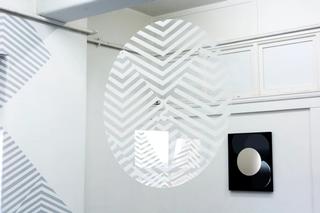







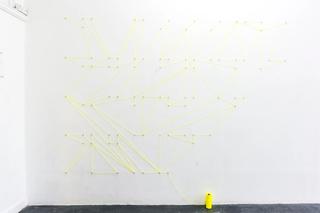

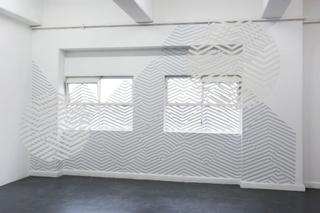

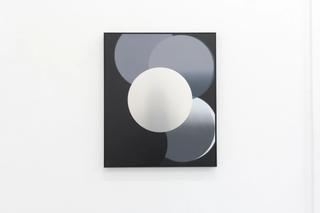

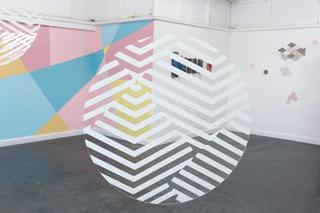

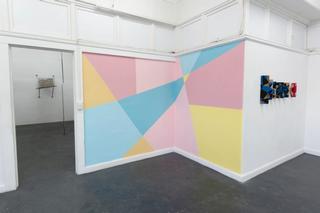

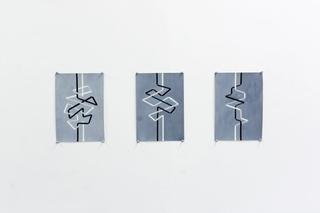

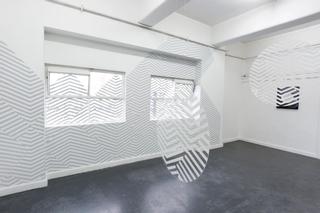

Plexus was a group show of Australian artists who work with geometric abstraction and spatial intervention. These ‘process-based’ abstractionists each used self-designed systems to generate their artworks. Deriving from the Latin ‘to braid’, the title refers to an intricate system or network of parts.
This program takes place on the land of the Wurundjeri people of the Kulin Nation. We recognise that sovereignty was never ceded - this land is stolen land. We pay respects to Wurundjeri Elders, past, present and emerging, to the Elders from other communities and to any other Aboriginal or Torres Strait Islanders who might encounter or participate in the program.
Will Cooke is a Sydney based artist whose practice adopts abstraction to understand the connection between body and mind. Cooke is intrigued by the invisibility of memory, and the way it is experienced within the body. He explores his own personal mythologies and memories, and attempts to make these internal thoughts and experiences external. He makes illusion-based paintings that begin a dialogue, and thus, the work develops a sensory relationship with the viewer. Cooke uses various supports, such as aluminium, canvas and paper, to concrete the sensation of memory in the physical. Cooke’s focus on the relationship between form, surface, and the viewer, produces independent physical objects that transcend the mind. Will finished a Bachelor of Visual Arts (Hons) at Sydney College of the Arts (SCA) in 2011. Cooke has shown in numerous group exhibitions around Australia and has had solo exhibitions with NKN Gallery, Melbourne (2017), Alexandra Porter, New York (2016), NKN Gallery, Melbourne (2016), Chalk Horse, Sydney (2015).
Will is represented by NKN Gallery, Melbourne.
Annelies Jahn is a Sydney-based multi-disciplinary artist. Her art practice investigates ideas of space, relationship and temporality as they are experienced through things or objects, and space or place. The contingency of these perceptions is observed via the agency of measure to become a process of art-making. Annelies’ work has been exhibited in group shows both in Australia and overseas. She has had solo shows and short residencies in Sydney. Her work is held in the National Art School Archive and in private collections. Annelies has held an extensive professional career (thirty years) in graphic design and publishing, working in Sydney and London. She has since completed her Master of Fine Arts at The National Art School, Darlinghurst. Annelies is a sessional and public programs teacher of Drawing at the National Art School. She is a Director at the Sydney ARI, Stacks Projects Inc., having previously acted as a director at ES74 Gallery, 2015-2016. Annelies was awarded in the .M Contemporary, YAI 2015. She was the recipient of Coutts Family Award for Excellence in Drawing, FONAS Drawing Award and has been a finalist in the John Olsen Drawing Prize.
Ham Darroch is an Australian artist working in sculpture, performance and drawing. His sculptures are created from existing objects which are altered and redirected using colour to reveal new meanings. His paintings are inspired by the action of everyday objects. His imagery is universal evoking shared histories and experiences, place and perception while revealing a deep sensitivity to the optical effects of geometric colour. In early 2006, he completed an MFA (research) COFA University of New South Wales and in 1997 a Bachlor of Arts from Australian National University. From 2006 he worked as an assistant to Bridget Riley.
Lieutenant + VassalloJames Lieutenant + Kate Vassallo have created large-scale, wall-painting artworks as a collaborative pair since 2013. Currently based in Canberra, the pair previously lived and worked in Sydney from 2011-2018. They each completed a Bachelor of Visual Arts (Honours) from the Australian National University School of Art in 2010, where they met. Since then they have each sustained a solo practice while also working together. The collaborative pair has delivered highly praised solo exhibitions at respected ARIs and institutions throughout Australia, including Canberra Museum and Gallery, Bus Projects (Melbourne), Archive Space (Sydney) and Canberra Contemporary Art Space. Lieutenant + Vassallo have also been engaged for commission projects by institutions including Artbank, Goulburn Regional Gallery/Goulburn Mulwaree Council and 4A Centre for Contemporary Asian Art, as well as private clients.
Nadia Odlum is an emerging artist and researcher from Sydney, Australia. Her work explores the perceptual experience of navigation within urban and architectural environments. In particular, she is interested in the connections between vision and movement in perception, and the way the various sensorimotor capacities of the body impact on our understanding of and feelings within physical space. Her practice spans drawing, painting, sculpture, and installation. Nadia completed a Bachelor of Fine Arts (Honours) at the National Art School in 2012, graduating with First Class Honours and the Award for Outstanding Academic Achievement. In 2016 she completed a Master of Fine Arts by research at UNSW Art & Design, for which she was a recipient of the Australian Postgraduate Award. She has presented work at the Museum of Contemporary Art Australia, the New York Transit Museum, The Murray Art Museum in Albury, Artspace, Firstdraft and Penrith Regional Gallery. In 2018 she was an Artist in Residence and Education Fellow at the Wassaic Project in New York.
Katy Mutton is an Australian interdisciplinary visual artist whose work frequently explores the machinations of politics and the dichotomies of technology in popular culture. Her work exploits the manipulation of perception through pattern and employs diverse materiality. Her work engages with data visualisation and visual language systems and spans drawing, printmaking, painting, installation and public art.
Katy’s work is held in many public and private collections including The Australian War Memorial, Bega Valley Regional Gallery, City of Yarra VIC, Curtin University Collection WA, Mildura Regional Gallery, The Molonglo Group, The State Library of Victoria.
Britt Salt's practice is an ongoing spatial experiment where fundamental elements such as line, form and space intertwine. Employing repetition and materials that have an inherent ability to create movement, her work centres on the symbiosis of art and architectural practice and questions how these genres influence the notion of place and impermanence in contemporary urban environments.
Britt received the Freedman Foundation Travelling Scholarship for Emerging Artists in 2010, which supported residencies in the U.K., France and China. In 2015 she undertook a residency in Tokyo, which culminated in a public installation at Youkobo Art Space. Her work has been selected as a finalist in numerous awards including the Paramor Prize 2017 and Gold Coast Art Award 2015. Most recently Britt has completed residencies at Arteles (Finland), Heima (Iceland) and the Australian Tapestry Workshop. She has worked on significant large-scale commissioned artworks for Fender Katsalidis Architects, Büro North and Asia Pacific Airports Melbourne.
Kate Vassallo is an Australian visual artist, currently based in Canberra. With an interest in process-orientated repetition, building material density and optical perception, Vassallo designs creative and materially driven systems to make her final artworks. Though currently focusing on drawing, her artistic practice spans a number of different media including printmaking, photomedia and installation.
Vassallo takes interest in the way that digital and contemporary culture has changed perceptions of art, imagery and aesthetics. Building on our visually cluttered, high-speed media consumption, she makes artworks that attempt to slow audiences down. These pieces simultaneously defy the digital through laborious handmade production, while also echoing the forms and generative systems of our everyday technology.
Related

18 Sep–5 Oct 2019
As We Pull the Earth Toward Ourselves
Yvette James
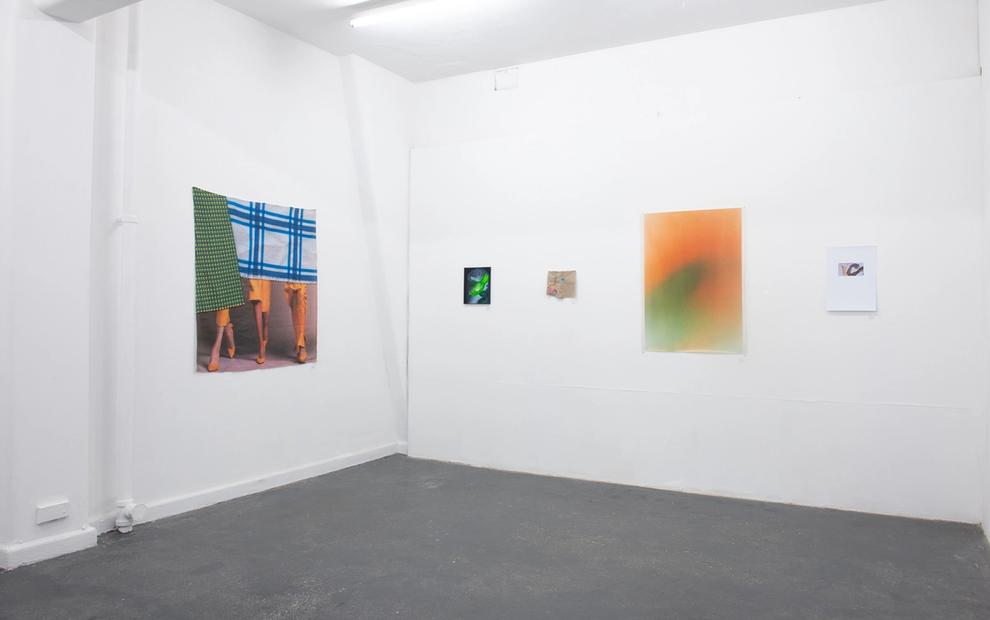
30 Oct–9 Nov 2019
B-SIDE 2019
Aaron Billings, Alex Walker, Cristal Johnson, Camila Galaz, Erin Hallyburton + Toy, Anna Dunnill, Britt Salt, Daniel Gawronski, Daisy Lewis-Toakley, Arini Byng, Billie Justice Thomson, Garth Howells, Jessie Turner, Levi Franco, Lachlan Stonehouse, Sandrine Deumier, Mia Middleton, Kirsty Macafee, Melanie Caple, Jordan Mitchell-Fletcher, Karen Casey, Paul Murphy, Lina Buck, Tyson Campbell, Steven Rhall, Tess King, Zainab Hikmet, Siying Zhou, Skye Malu Baker, Manisha Anjali, Haydn Allen, Georgia Anson, Olga Bennett, Seth Birchall, Phoebe Beard, Nicole Breedon, Kate Bohunnis, Tildy Davis, John Brooks, Mig Dann, Andrew Clapham, Lori Camarata, Lara Chamas, Lauren Dunn, Rachel Button, Ara Dolatian, MJ Flamiano, Jacquie Owers Gayst, Olive Guardiani, Emma Hamilton, Majed Fayad, Jessica Grilli, Stephanie Hosler, Erin Hallyburton, Zainab Hikmet, IchikawaEdward, Lucy Hughes, Abbra Kotlarczyk, Yvette James, Therese Keogh, Jackie De Lacy, Kaijern Koo, Shivanjani Lal, Anna May Kirk, Tess King, Lou Hubbard, Holly MacDonald, Lachy McKenzie, Kari Lee McInneny McRae, Anna McDermott, Tahlia McCuskey, Kirsty Macafee, Madeleine Minack, Christine McFetridge, Tamara Marrington, Josephine Mead, Brahmony McCrossin, Georgiy Margvelashvili, Jordan Mitchell-Fletcher, Sean Peoples, Sanja Pahoki, Lia Dewey Morgan, Betty Musgrove, Sophie Morrow, Katie Paine, Anatol Pitt, Olivia Mròz, Ruth O’Leary, Lekhena Porter, Steven Rhall, Cailtin Royce, Sara Retallick, Roberta Rich, Chunxiao Qu, Lisa Radford + Sam George, Marko Radosavljevic, Britt Salt, Aaron Christopher Rees, Rachel Schenberg, Jade Spokes, Tai Snaith, Ben Sheppard, Darcy Smith, Molly Rose Stephenson, Clare Steele, Jacqui Shelton, Leyla Stevens, Lizzy Simpson, Dell Stewart, Adam Stone, Jacqueline Stojanović, Madeleine Thornton-Smith, Camille Thomas, Lachlan Stonehouse, Masato Takasaka, Lesley Turnbull, Hana Vasak, Henry Trumble, Parkin Vatanajyankur, Leanne Waterhouse, Patrick Zaia, HeeJoon Youn, Grace Wood, Benjamin Woods, Zoë Bastin, Kawita Vatanajyankur

8–25 May 2019
Standing In Red
Daisy Lewis-Toakley











